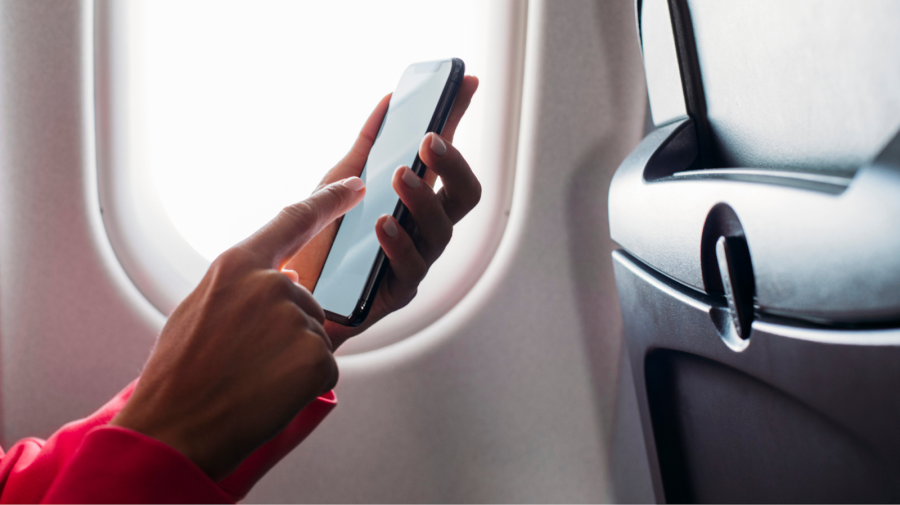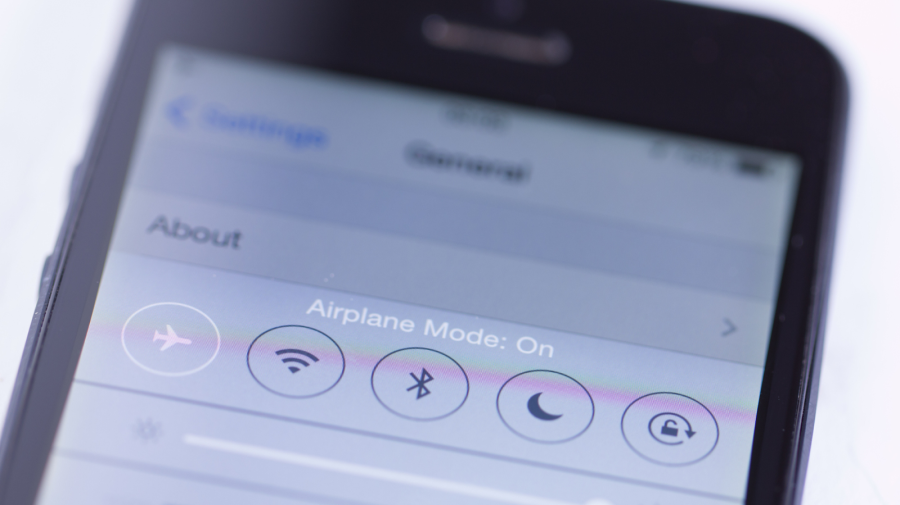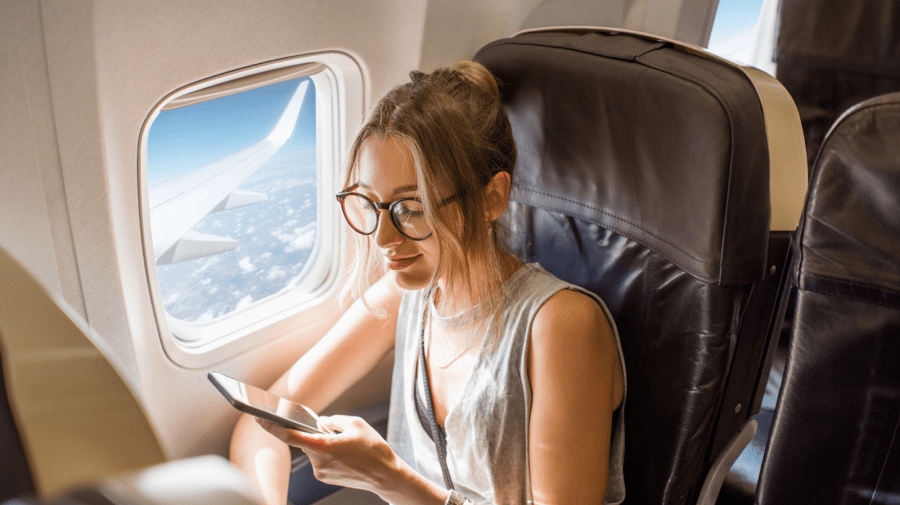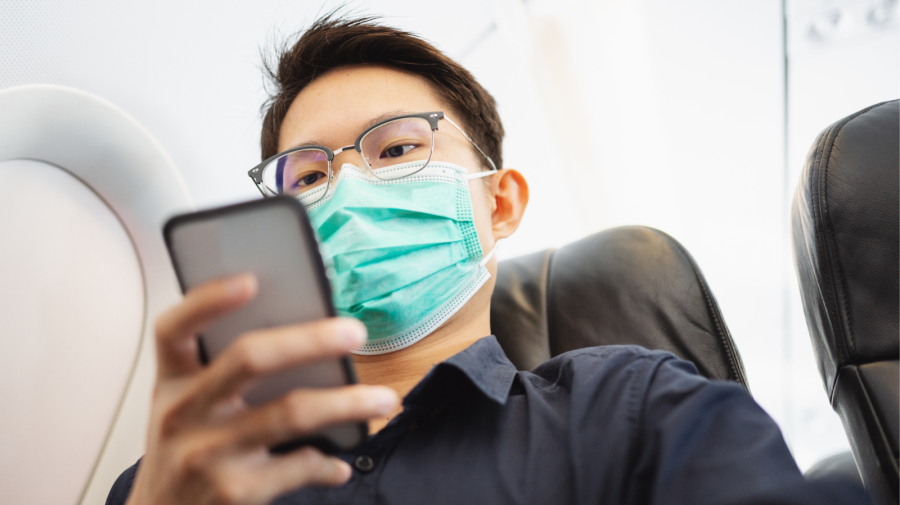
When you’re traveling by air, finding ways to stay entertained and connected is often essential. Since many people rely on their mobile phones for both of those, it’s common to wonder, “Can I use my phone on a plane?” If you’re asking that question, here’s what you need to know.
Can You Use Cell Phones on a Plane in 2022?
Currently, you can use cell phones on planes, but only in specific capacities. There are strict rules outlined by the Federal Communications Commission that bar certain phone-related activities. However, other uses are fine.
Generally, you can’t use cellular service for any purpose while on a plane, as interference from cellular tower signals can impact aircraft instrumentation and create safety issues. While a regulatory proceeding once aimed to make that an option on U.S. flights, it was struck down by the FCC in 2020. That means using cellular service for making calls, sending texts, or using apps that rely on cellular service-based data isn’t allowed.
Using a phone in airplane mode or connecting via airline-provided WiFi is often permitted. However, airlines have the ability to limit that activity as necessary, both in regard to ensuring safety and the comfort of other passengers.

Can You Make Phone Calls on a Plane?
You can’t make phone calls on a plane using cellular service, as using cellular service for any reason isn’t permitted. WiFi calls may be allowed, though that’s at the discretion of the airline, as it impacts passenger comfort.
Can You Text on a Plane Without WiFi?
Texting on a plane without using WiFi generally isn’t permitted. As with calls, texts use cellular service, and that has to be turned off during flights.
Is Airplane Mode Necessary?
There’s a bit of a debate regarding the need to restrict cellular service use while flying. However, the FCC made a decision to ban using cellular service while on a plane. Airplane mode simply serves as an easy way to comply with the rules. However, you can also choose to turn the device off completely, as that can also prevent the device from connecting to the network.

What Is Airplane Mode?
Airplane mode is a phone setting that disconnects the device from the cellular network and radio signals. It’s designed as a quick way to comply with requirements while on an aircraft, as airplane mode can typically be engaged by tapping a single icon – which usually resembles a plane – in the tools tray.
Does Airplane Mode Save Battery?
Generally speaking, airplane mode does reduce battery usage when compared to using the phone in a similar fashion while connected to a cellular network. When connected to a cellular network, a phone is continuously searching for and pinging nearby cell towers, an activity that happens in the background and requires additional battery power. With airplane mode on, that background activity isn’t occurring, reducing power usage.
Does Bluetooth Work in Airplane Mode?
Bluetooth does work when a cell phone is in airplane mode. Most Bluetooth devices rely on short-range signals, so they don’t interfere with aircraft instrumentation or operation. As a result, airlines and the FCC typically don’t restrict the use of Bluetooth connectivity. However, they may require larger Bluetooth devices to be stowed during takeoff and landing for safety purposes.
Why Can’t You Use Your Phone on a Plane?
The primary reason you can’t use cellular service while on a plane is that it’s a safety concern. Some cellular technologies can interfere with aircraft instruments, which can be dangerous. However, there are also concerns about passenger comfort. Allowing passengers to make calls during flights could be disruptive to others, so most airlines would prefer to avoid that situation.

Additionally, cellular connections are based on securing service from a cell tower. While transitioning between towers is simple when traveling on the ground, the speed at which you pass from one to the next while flying is far quicker. As a result, there’s more of a load on the broader system, particularly in dense, urban areas with numerous towers that a device may try to ping all at once.
Can You Charge Your Phone on a Plane?
Charging your phone while on a plane is allowed. However, not all aircraft have outlets that passengers can use. While traditional power outlets or USB outlets are increasingly common, they aren’t universal. If they’re unavailable, you can only charge your phone if you have an alternative available.

For example, you can bring a portable power bank or portable charger onto a plane and use that to charge your phone. If you have a laptop with you, using that to charge your phone may be an option as well, though that will put additional strain on your laptop battery, which could cause your laptop to run out of battery faster.
Do Planes Have WiFi?
Yes, many aircraft do have WiFi service, including the vast majority of airplanes used for larger domestic and international flights. However, it isn’t universally available. Some older or smaller planes may not be equipped to provide WiFi connectivity.
How Does WiFi Work on Planes?
Since using cellular service on a plane isn’t allowed, many people wonder how the WiFi on planes works. In most cases, the aircraft connects using antennas, either relying on satellites or ground towers to provide passengers with a connection.

How Much Does WiFi Cost on a Plane?
The price of WiFi on a plane varies by carrier. JetBlue offers the service for free to every passenger on most US domestic flights and select international flights, suggesting the aircraft can support the offering. Alaska Airlines charges $8 for the service. United Airlines charges $8 or $10, depending on whether you’re a MileagePlus member, though eligible T-Mobile subscribers can access it for free starting in the fall of 2022.
If you’re preparing for a trip and are worried about the WiFi cost, you can typically find out how much it is by reviewing the airline’s website, typically in the in-flight entertainment section. Generally, you have to use a credit or debit card to pay the fee while on the flight, but you may have the ability to cover the cost in advance with some carriers, which may be more convenient.






